Like many other people who struggle with depression, I sometimes feel as if there is some sort of malevolent force lurking in the sky, consciously plotting to sabotage my happiness at every turn. This can range from the petty (dropping a glass or tripping on something that didn’t seem to be there the moment before) to the profound (experiencing a string of life tragedies so cruel that they seem the product of a conscious plan). I sometimes envision someone like Alan Rickman sitting in front of a bank of computers in a control tower somewhere, looking down on me, sending out random acts of chaos and misery and chuckling, “He hasn’t seen this trick before…” The new Dark Horse comic by Ryan K. Lindsay, illustrated by Manifest Destiny alum Owen Gieni titled Negative Space reassures me that I’m not the only one with such fantasies, and fully exploring them can be a source of adventure, intrigue and a deliciously dark sense of humour. It’s one of the best new books I’ve read this year, combining the Lovecraftian sci-fi vision of Nameless with a healthy dose of cynical gallows humour reminiscent of Louis CK’s TV series Louie.
The “hero” of the book is a character with so much gender ambiguity that Lindsay names him “Guy”. Guy is a struggling writer and like many in that situation (raises hand), he’s profoundly depressed. The first panel shows him in his cluttered little apartment, a rope ready to carry out his final exit, and yet when Guy comes to write his suicide note, he has, of all things, writer’s block.
A suicide note, for a writer, is an important project, probably the last gasp of a long career, like the final song in Walk Hard that will “sum up Dewey Cox’s entire life.” With stakes that high, it’s easy to imagine that a skilled writer might get hung up on that final step. His only friend, it seems, is Woody, who runs a van-based coffee shop/snack truck in a nearby plaza. Woody, unlike Guy, is a positive sort of person, always encouraging and upbeat, but without seeming naive or brainwashed. (Depressed people are always skeptical about and wary of very positive folk. But Woody’s character rings true. The relationship between the characters doesn’t seem forced, which is quite a feat.)
It turns out that there actually are controllers in a tall building who deliberately try to sabotage Guy’s happiness, and the happiness of the world in general, for their own purposes. Guy is an empath, capable of spreading emotions through his writing with a particular power. Other people get depressed, but Guy is capable of spreading that depression around and amplifying the gloom. That alone is a great metaphor for the power of art to influence emotion, and how important art can be in setting the cultural tone. In this case, like many great science fiction conceits, the book simply takes the metaphorical and makes it literal, to darkly hilarious results. (At one point, the controllers start their latest project to depress Guy by exclaiming, “Let’s give him the full Polanski!”)
Believe it or not, but in that short summary of the premise are no real spoilers: we learn all of this in the first four pages of issue #1. Things get much stranger from there, involving creatures from below, big government organizations and a ragtag group of rebels fighting to promote positivity in the world. As a metaphor for the fight against depression, it’s funny, moving and achingly true. I’ve rarely seen a braver book about depression, other than something like The Bad Doctor by Ian Williams or of course American Splendor.
Guy himself has to be one of the most improbable heroes ever to appear in the comics medium. Drawn with a doughy body and forlorn, long face, he’s the precise opposite number of a superhero, or even a conventional non-super hero. This choice bravely undermines comics storytelling conventions in a profoundly refreshing way. Owen Gieni’s art, with its delicate pastel palette and pencil shading, is perfectly suited to the mad world being portrayed, especially as some of the creatures who will form the spine of the plot are revealed. Without spoiling anything, I can confidently assert that those who appreciate the more grotesque side of Manifest Destiny will find something to love here. No one draws an angry flower better than Owen Gieni. (Except possibly Stephen Notely, but his strip is titled Bob the Angry Flower, so he’s spent a lot of time on the subject.)
Even with all the nods to Gothic and Grotesque horror, Negative Space is instantly comprehensible and light on its feet. World-building in this kind of story can get out of hand very quickly, but Lindsay and Gieni draw an admirable straight line through the narrative and we’re never lost, as readers. Even the inevitable exposition sequences in the second issue (there are only two so far) are easy reads, setting up the world in simple terms so we can forget about the various species and organizations and just focus on Guy’s journey into the forces that create depression.
Depression, as a disease, has a way of driving people apart and encouraging individual isolation. Comics like Negative Space are so important because they bring us together in our depression, and remind us that we’re not alone and actually, when one renders out the fantasy that emotions are being manipulated to nefarious ends, the satire does what all great satire is supposed to do: make us laugh at ourselves. Which means, of course, that we’re laughing. Negative Space is more than a comic: it’s true graphic medicine.



















































